 Natural gas fell for a second day on Thursday on expectations the Energy Information Administration will report U.S. gas inventories rose above the average last week despite the recent below-average temperatures in the eastern half of the country. Projections that U.S. output will rise further in 2013 also weighed on the market.
Natural gas fell for a second day on Thursday on expectations the Energy Information Administration will report U.S. gas inventories rose above the average last week despite the recent below-average temperatures in the eastern half of the country. Projections that U.S. output will rise further in 2013 also weighed on the market.
On the New York Mercantile Exchange, natural gas futures for settlement in December fell by 1.32% to $3.519 per million British thermal units by 12:53 GMT. Prices held in a range between days high of $3.567 and a one-week low of $3.514 per mBtu. The energy source lost 2.5% on Wednesday, the most since November 3, and extended its weekly decline to over 1.0% on Thursday.
Natural gas fell for a second day on expectations that EIAs weekly natural gas storage report, due today at 15:30 GMT, will show U.S. inventories rose above the average last week. According to a Bloomberg survey of 18 analysts, stockpiles jumped by 22 billion cubic feet, exceeding the five-year average increase of 19 billion and last years 12 billion gain during the comparable week.
The energy source was also pressured after the Energy Information Administration reported today that U.S. output may jump to 70.29 billion cubic feet per day in 2013, 0.4% above the previous months estimate of 70 billion. If confirmed, current years production will be 1.6% above 2012s record high of 69.18 billion cubic feet per day.
The steadily increasing U.S. output has risen to record high levels in the past months as technologies such as fracking provided a cheaper way to drill into shale rock and extract fuel. The EIA said the Marcellus shale has been the main driver of growth.
Teri Viswanath, director of commodities strategy at BNP Paribas SA in New Yory, commented for Bloomberg: “The concern is that we still have ample supplies to meet this upcoming heating demand. That, combined with expectations of continued production growth, is making investors think twice about running this up.”
Losses however were limited as weather forecasts continued to call for below-normal temperatures in some of the most densely-populated U.S. areas. MDA Weather Services in Gaithersburg, Maryland, reported that readings from the eastern U.S. through the Midwest will be below-average between November 18 and November 27, stoking demand for the power-station fuel. According to AccuWeather Inc., temperatures in New York on November 20 may bottom at 27 degrees Fahrenheit, 13 below usual, while the low in Chicago may be 23 degrees Fahrenheit, 9 below average.
When cold weather is expected, natural gas surges as increased electricity demand to power air-conditioning calls for more supply of the fuel, which is used for a quarter of U.S. electricity generation. Consumption usually picks up from November through March. According to the Energy Information Administration, power generation accounts for 32% of U.S. gas demand and 49% of U.S. households use the energy source for heating.
Last Thursday, the Energy Information Administration reported that U.S. natural gas inventories added 35 billion cubic feet in the week ended November 1, compared to the five-year average gain of 36 billion cubic feet and last year’s 27 billion increase during the comparable period. Total gas held in underground U.S. storage hubs rose to 3.814 trillion cubic feet, 2.9% lower than last year’s amount of 3.926 trillion. The surplus over the five-year average stockpiles narrowed by 0.1% to 1.5% from a week earlier, the report showed.





